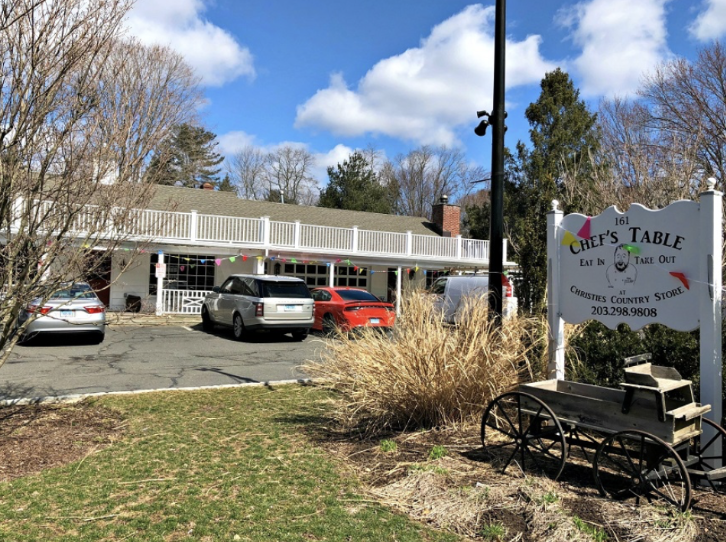Arguably the most important daily choices we have are about the food we eat. Fries or salad? Sandwich or pizza? In Westport and at Staples, the choices are ultimately ours.
![]()
With Chartwells, There’s More Than Meets the Fry
One chicken Caesar wrap provides about 24 grams of protein, 54 grams of carbohydrates, and 19 grams of fat. But this menu choice is more than just numbers on a nutrition label; it is a student’s lunch. Behind a split-second decision during second wave is a process that balances nutrition with flavor and requires the collaboration of the town of Westport, Chartwells, administrators, and members of the Food Service Advisory Committee.
“The cafeteria has a mix of foods that are healthy and good-tasting,” said Sarah Rountree ’14 as she waited for her panino to be pressed. Rountree mentioned the school’s offerings of whole wheat wraps and breads as good options that fulfill both taste and nutrition.
Although the bread has the telltale dark brown color of whole wheat, there are more subtle ways the cafeteria has changed its menu to offer more nutritious fare. For example, the breading on the chicken nuggets is now whole grain, as is the pizza crust.
These changes were enacted after discussion and evaluation by the Food Service Advisory Committee for the Westport Public School district. This group, which meets four times per year, discusses the health of the cafeteria food and gives the town feedback and ideas for the school menus.
The committee, which includes at least one representative from every Westport school, provides parents and students with an outlet to submit opinions on cafeteria cuisine. The committee’s base of members includes trained chefs who provide feedback on the taste of the food.
According to Abby Greenspun, a nutritionist in Westport and a Staples representative on the committee, the group primarily was focused on the appeal of food. However, in the past eight years, the focus has broadened to include nutrition.
For budgeting reasons, the town, in conjunction with Chartwells and with input from the committee, plans meals that are eligible for government subsidies. Meals that qualify for the subsidies must meet the USDA guidelines for school lunches, as outlined in the National School Lunch Meal Program.
The national guidelines require that the school offer meals within weekly ranges for protein and grains. For example, the guidelines require a range of one to two ounces of protein per day, a saturated fat intake below 10 percent of total calories, and call for flavored milk to be fat free.
However, the cafeteria’s menu is not based on strict standards alone; student preferences are also taken into account. Greenspun encouraged students to share their opinions with members of the committee. According to Chartwells Dining Services Director Frank Rupp, new products go through a sampling process before being served to students.
Despite the lengthy process of planning a menu, students’ reactions to the cafeteria food are mixed. “You can tell that the pizza is whole grain,” Casey Smith ’13 said. “I don’t like it.” Luis Cruz ’15 noted that healthier choices are less convenient: “The salad costs a lot,” Cruz said, “And you have to wait for most of the lunch period to get a sandwich.”
However, students recognize that the cafeteria offers broad choices, many of which are served as tasty choices, rather than for their nutritional value.
“Fries are just a choice to eat,” Brenden Price ’16 said. “They should keep them.”
Price expressed appreciation for the ability students have to independently choose from the variety of foods in the cafeteria.

Principal John Dodig was unconcerned by cafeteria treats like cookies and fries. “Our kids eat healthily,” Dodig said. “They go to the gym, ride bikes, and a majority plays sports after school.”
Due to the health-conscious nature of the town, there is room for the school to opt out of the government subsidy in certain situations. At the beginning of this year, sandwiches were briefly changed to meet the government regulations of a maximum of two ounces of meat per sandwich.
“A slice of pizza leaves students feeling greasy and a salad leaves them hungry,” Schindler said. “I think it’s a work in
progress that is constantly being adapted to meet the needs of Staples students.”
The process of menu planning is never static. It occurs constantly behind the scenes of the sandwich lines and lunch tables. The town has been increasing offerings of fruits and vegetables for several years, ahead of the federal USDA regulations, Rupp said.
The town is also one step ahead of dairy requirements. For five years, Westport schools have served milk that is either 1 percent or fat free. Just this year, the USDA enacted that milk must be 1 percent or skim.
Westport school menus are also shifting to decrease processed foods. These steps, developed from committee discussions and collaboration, are not government required and are ahead of the curve.
The improvements will simultaneously fuel a healthy lifestyle and appeal to students’ taste buds.
Graphic above by Olivia Crosby ’15 (right)
 Local Teens Eat Healthier Than Most Nationwide
Local Teens Eat Healthier Than Most Nationwide
It almost goes without saying: America has a love affair with fast food.
With an annual business revenue of $110 billion, with 160,000 fast food restaurants across the country, with one in every four Americans served daily at a fast food chain, our fixation with fat-filled food has contributed in making over one-third of the country obese.
And yet, according to the Centers for Disease Control and Prevention, Connecticut has the second-lowest obesity rate of all 50 states.
How and why do Westporter teenagers manage to stay fit and healthy, while a large portion of the country falls in the fast food franchise’s trip?
Karen Laramie, a certified clinical nutritionist in Westport, believes Westporters are healthy because they are educated. “From an early age, children are taught in health class and by their parents the importance of nutrition,” Laramie said. “This helps with future food choice making.”
This education begins in the Westport school system. According to Dave Gusitsch, K-12 Physical Education and Health Curriculum Coordinator, health class begins at the elementary level and becomes a regular occurrence in middle school and throughout high school.
“The goal is to educate students to make good choices on a day to day basis,” Gusitsch said.
This education is evidently not lost on students. Katie Smith ’14, for example, is a student who strives to be healthy and believes the habits she has learned in school have been engrained in her.
“As early as I can remember, P.E. and health classes at school have stressed the importance of eating healthy and exercising. Personally, I was brought up eating a ton of fruits and vegetables, so healthy food became normal for me,” Smith said.
Fitness trainer Jimmy Coscina, owner of FitJim in Westport, has another hypothesis for why Westport teenagers live a healthy lifestyle: parents. He believes Westport parents influence their children, enabling them to afford personal training and gym memberships, not to mention Staples’ top-notch athletic program.
 “Kids learn from their parents’ habits and have plenty of exercise opportunities,” Coscina said.
“Kids learn from their parents’ habits and have plenty of exercise opportunities,” Coscina said.
Sherri Raifaisen, a Westport mother who attests to Coscina’s theory, has four daughters who have either graduated from or are currently at Staples. She believes she’s similar to other Westport parents who have instilled healthy values in their kids and also believes firmly in the phrase “everything in moderation.”
“That’s why I have a pantry full of snacks. I try to encourage my kids to eat healthy, but you shouldn’t deprive yourself,” Raifaisen said.
Varsity soccer player Jack Scott ’14, who said he indulges occasionally much like Raifaien recommends, thinks his diet should ultimately support his passion. “I eat fast food every now and then, but I know eating it too often is a poor decision, it’ll only hurt my health and my athletic ability.”
Parents act not only as insight, but also as means of something else very important: money.
A 2004 Time Magazine article about the relationship between economics and health reports that one in four adults below the poverty level is obese, compared with one in six in households with an income of $67,000 or more. The article notes that children from less-wealthy families face an even greater challenge in fighting obesity because the schools many of them attend are more likely to make budget cuts on physical-education classes.
Westport is an affluent area where healthy eating is a feasible, affordable option, according to Sloane Cooper ’15: “Westport teens eat healthier because we are able to buy more organic foods which costs more money but are healthier for you,” said Cooper.
A study by Dr. David Ludwig from Boston Children’s Hospital found that after surveying 6,212 children and teens, those who ate fast food consumed significantly higher amounts of saturated fat, carbohydrates, sugar, and calories per gram of food compared to those who did not. They also had less fiber, milk, fruit, and vegetables in their diets.
Health teacher Kelly Garrity supports Ludwig’s study by explaining the negative impact of fast food.“Some of the negative effects of fast food can include headaches due to nitrates in the processed food,” Garrity said. “With the high levels of sugar and fat in most fast foods we often feel a spike of energy which fades quickly leaving us feeling not so good and even craving more unhealthy food.”
Westport can afford to be thin and healthy. Extensive nutrition units in health classes, a comprehensive athletic program including 74 teams, and influential parents all collectively contribute to making Westport an environment where teens can find a balance between diet and fitness. At the end of the day, however, the occasional order of McDonald’s fries may be just nearly impossible for any hungry teenager to resist.






















































